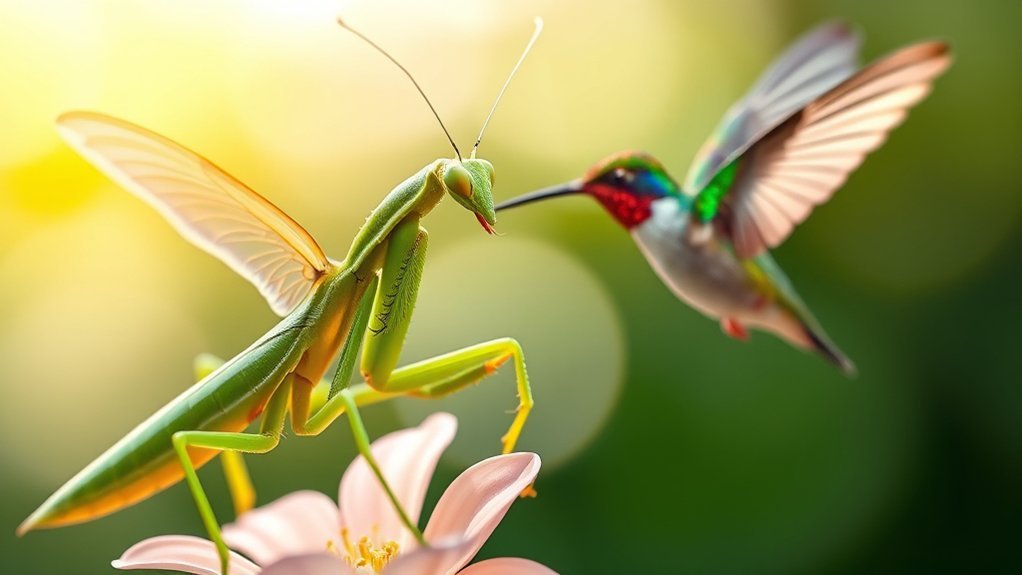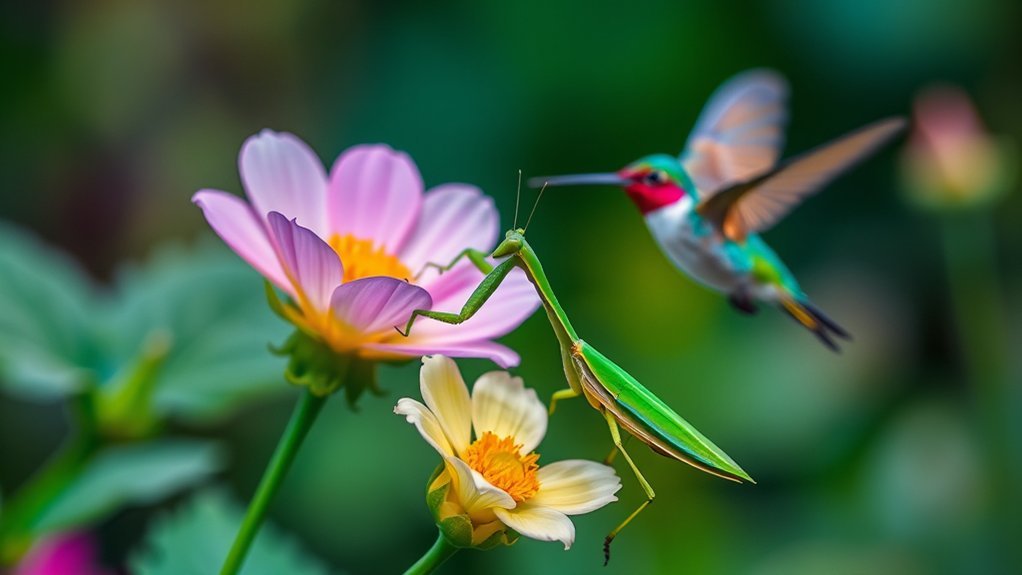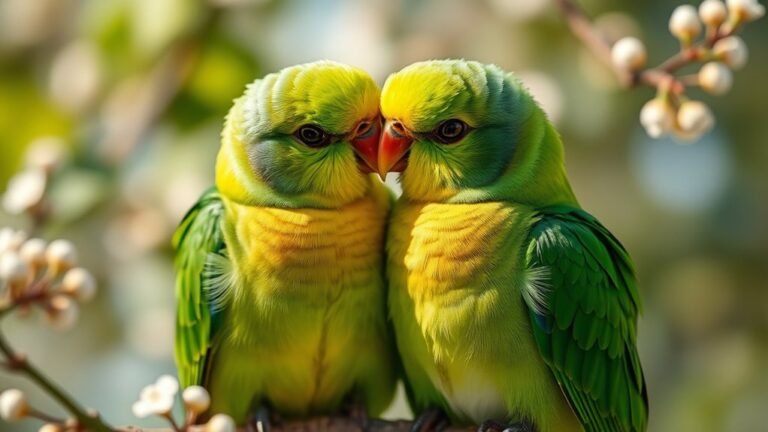Will Praying Mantis Attack Hummingbirds? Understanding the Risks
Praying mantises are known for being good hunters, but they don't usually pose a big threat to hummingbirds. Sometimes, bigger mantises might try to catch young hummingbirds, but most of the time, hummingbirds are just too fast and agile to get caught.
So, what can we learn from their interaction? It's interesting to see how they both fit into nature. There are a few things that might affect their rare meetings. For example, the size of the mantis and the age of the birds can play a role.
To keep your hummingbirds safe, you can take some simple steps. Make sure they have plenty of flowers to feed on and avoid using pesticides in your garden. Keeping an eye on your garden can also help you spot any mantises before they can cause problems.
In the end, while the risk of mantises attacking hummingbirds is low, being aware can help protect your feathered friends and keep your garden lively and safe.
A Quick Overview
Praying mantises mainly eat insects and small creatures. They can be a risk to hummingbirds if the birds are caught off-guard.
Hummingbirds are really fast and quick, which makes it hard for mantises to catch them when they are flying around.
Praying mantises hunt by waiting to catch their food, so they might go after a hummingbird if the bird is not moving.
Flowers can attract both hummingbirds and mantises. When they are near each other, there is a chance they might meet.
Although mantises have strong front legs to grab their food, they usually go for easier prey and do not actively hunt hummingbirds.
Overall, while there can be some risk, it's not common for mantises to attack hummingbirds.
The Praying Mantis: An Overview of Its Characteristics

The praying mantis is a cool insect with a pointy head and a long body. People who love nature and scientists find it fascinating. It has great camouflaging skills, which means it can blend into its surroundings. This helps it catch its food easily. You can often spot mantises sitting on leaves or flowers, waiting for insects to come close.
One of the most interesting things about praying mantises is how they behave when they mate. Sometimes, the female mantis eats the male mantis after they mate. This might sound harsh, but it helps the female get the nutrition she needs for laying eggs. This behavior shows how the mantis has adapted to survive in nature.
Learning about these unique traits can make you appreciate praying mantises even more. They play an important part in our ecosystem. Knowing about them can bring nature lovers together, sparking discussions and sharing of experiences.
Hummingbirds: A Closer Look at Their Behavior and Diet
How do hummingbirds keep their energy up? These amazing birds mostly eat nectar, which they drink many times during the day. They've super-fast bodies and can drink twice their body weight in nectar every day!
Some hummingbirds are very protective of their feeding spots. They'll chase away other birds to keep their food safe. This makes for some exciting fights in the air!
Besides nectar, hummingbirds also snack on tiny bugs and spiders. These give them extra protein.
Watching hummingbirds helps you see how interesting their lives are. Their behaviors show how they find food and stay energized. Don't you think it's fun to learn about these tiny birds?
The Natural Predator-Prey Relationship

While learning about hummingbirds, it's important to see how they fit into nature's predator-prey picture.
Hummingbirds have cool ways to escape from animals that want to catch them, while their hunters use special skills.
- Hummingbirds fly fast and move quickly to stay safe.
- They hide in leaves to stay out of sight.
- Predators, like mantises, stay very still while looking for food.
- Hummingbirds need to time their eating right to avoid trouble.
- Both hummingbirds and their predators must be aware of their surroundings.
Understanding these behaviors helps us appreciate nature even more!
Praying Mantis Hunting Techniques
The praying mantis is a cool hunter in nature. It uses some smart tricks to catch its food. One of its best skills is blending in with its surroundings. This helps it stay hidden while waiting for insects to come by.
When the time is right, the mantis moves quickly to grab its meal. It uses its strong front legs to catch bugs with great accuracy. This mix of being sneaky and fast helps the mantis hunt a variety of prey.
Size and Strength Comparison: Mantises vs. Hummingbirds

Praying mantises and hummingbirds are two amazing creatures. They both have unique skills that help them in their own ways.
Praying mantises are small but strong. They usually measure about 3 to 4 inches long. They're expert hunters that use their strong front legs to catch insects quickly. They rely on sneaky ambush tactics to surprise their prey.
On the other hand, hummingbirds are a little larger, ranging from 3 to 5 inches. They're super fast and can beat their wings very quickly. This helps them escape from danger easily. Hummingbirds can fly in any direction, making them very agile.
When we look at their strengths, it's clear that size doesn't define their power. Mantises use their technique to catch their food, while hummingbirds use speed and agility to avoid threats.
Understanding how they work helps us appreciate both creatures. They may be different, but they're both fascinating and effective in their own ways!
Documented Instances of Praying Mantis Attacks
Praying mantises usually eat smaller insects, but sometimes they go after much bigger creatures. There are reported cases of mantises catching birds, like hummingbirds. These events don't happen often, but they show how clever and adaptable mantises can be when hunting.
Most of the time, mantises sneak up on their prey. They wait patiently for the right moment to strike.
But if a hummingbird comes to feed near where a mantis lives, the mantis might take advantage and make a quick attack.
Understanding these unusual stories helps us see how mantises fit into their world. It's fascinating to learn how these insects can sometimes surprise us with their abilities.
Environmental Factors Influencing Interactions
Interactions between praying mantises and hummingbirds are influenced by their surroundings. Here are some of the main environmental factors that affect their relationship:
- Habitats: Praying mantises like areas with lots of plants where they can hide and hunt. Hummingbirds need flowering plants to get nectar, which helps them survive.
- Seasons: Changes in temperature and weather can affect food sources and where animals build their nests. This influences both mantises and hummingbirds.
- Predators: If there are other predators nearby, it can change how many mantises are around and how hummingbirds behave.
- Human activity: When people build cities and homes, it can disrupt natural habitats. This often brings mantises and hummingbirds closer together.
- Plant variety: A wide range of plants creates a healthier environment. This can lead to fewer fights between the two species.
Understanding these factors helps us see how both creatures fit into nature's balance. It's fascinating to think about how they share their space and find ways to survive!
Precautionary Measures for Hummingbird Enthusiasts
If you love watching hummingbirds in your garden, it's very important to keep them safe. Here are some simple steps you can follow.
First, place your hummingbird feeders away from thick bushes. This way, praying mantises can't hide there and catch the birds. Make sure your garden is open and easy for the birds to see any danger around them.
Next, check your feeders often. Look for dirt or bugs that can make the food unsafe. Clean them regularly to keep the feeding areas safe.
You can also plant flowers that attract hummingbirds. Choose native plants, as they help keep larger insects away.
Keep an eye on the praying mantis population. If you see more of them around, try moving your feeders to a different spot for a while.
Frequently Asked Questions
Do Praying Mantises Pose a Threat to Other Small Birds?
Praying mantises can be a danger to small birds, especially when they are hunting. Watching how birds act can show us how exposed they are to these insects. This relationship helps us appreciate how different animals depend on each other in nature.
When a mantis is ready to catch its meal, it can grab a small bird. This makes it important for us to watch how birds behave when mantises are around. Knowing this can teach us more about the food chain and how it all works.
Understanding these simple interactions can make us more curious about the world around us. It's fun to learn how all creatures fit into nature's puzzle.
What Attracts Praying Mantises to Hummingbird Habitats?
Praying mantises go to hummingbird habitats because of the hummingbird feeders. These feeders attract many insects, and that makes a great hunting spot for mantises. They use their sharp eyes and quick movements to catch small bugs that come to the feeders. So, when you see a hummingbird feeder, you might also spot a praying mantis nearby, eager for a tasty snack!
Can a Hummingbird Escape a Mantis Attack?
Hummingbirds are really quick and agile. When a mantis tries to attack, these little birds can often dodge it. They move fast and can escape danger. Their quick reflexes help them stay safe from threats, showing just how amazing they are in tricky situations.
Are There Specific Mantis Species Known for Hunting Birds?
Some types of mantis, like the African mantis, are known to hunt birds. They are very skilled hunters. They can move quickly and quietly. Learning about these mantis species shows us how animals interact in nature. It highlights the relationship between predators and their prey.
How Do Mantises Recognize Potential Prey Like Hummingbirds?
Mantises see the world in a unique way. Their eyes help them spot movement and shapes easily. This skill allows mantises to recognize potential prey like hummingbirds.
When a mantis watches, it can tell if something is moving around. It quickly decides if that movement is a possible meal. Their sharp eyesight and quick reactions make them great hunters, even when facing small birds.

Joyce is the passionate founder of Chirping Hearts, a website dedicated to sharing her love for birds and providing valuable information about avian life. With a background in ornithology and years of experience in birdwatching, Joyce aims to inspire others to appreciate the beauty and diversity of birds. Through her engaging articles and guides, she hopes to foster a community of bird enthusiasts who share her enthusiasm for these incredible creatures. When she’s not writing, Joyce enjoys exploring nature trails and observing birds in their natural habitats.







